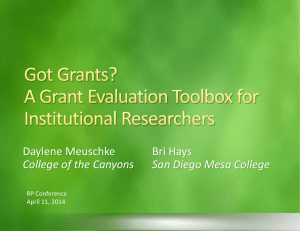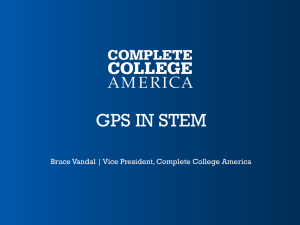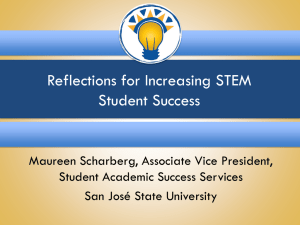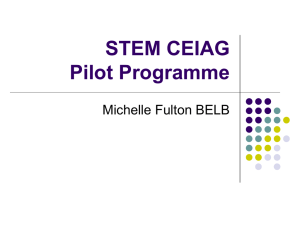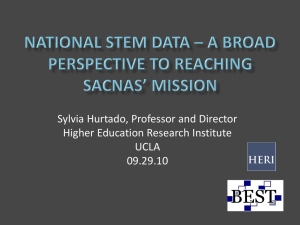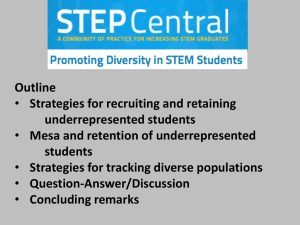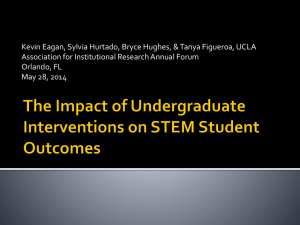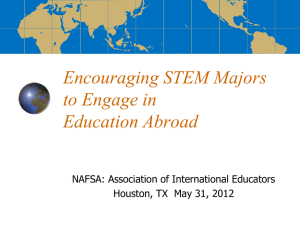H - Los Angeles Community College District
advertisement
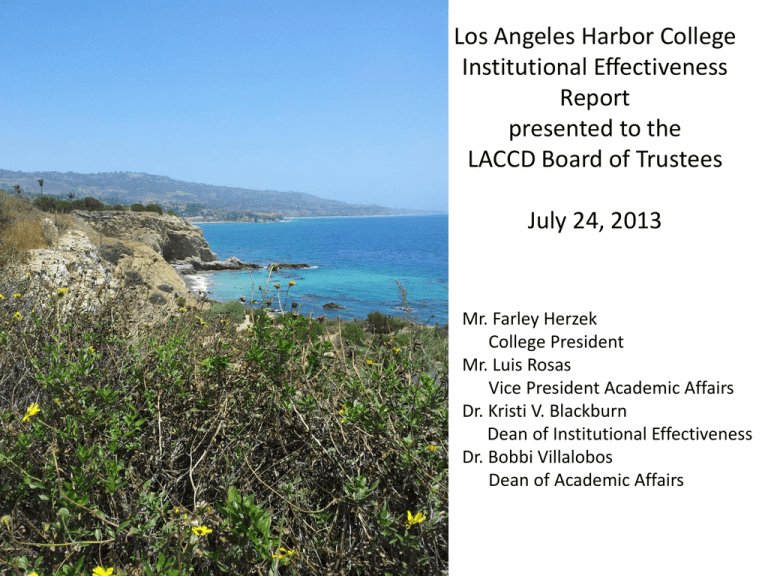
Los Angeles Harbor College Institutional Effectiveness Report presented to the LACCD Board of Trustees July 24, 2013 Mr. Farley Herzek College President Mr. Luis Rosas Vice President Academic Affairs Dr. Kristi V. Blackburn Dean of Institutional Effectiveness Dr. Bobbi Villalobos Dean of Academic Affairs College Strategic Plan: Priorities & Outcomes LAHC Educational Master Plan 2013-17 • FTES growth plan • 4%+ • Deans/Faculty developed plan to reach 7300 FTEs • Increase retention/persistence/ transfer/degree and certificate completion • Student Success (implementation of SB1456) • Continue Infrastructure Support • 3 years of balanced budget (including surplus 2013) • SLOs and Accreditation District Strategic Plan: 2011-12 Baseline Data Percentage of eligible students receiving financial aid Harbor Mission Pierce Southwes t Trade-Tech Valley City East West DISTRICT Pell Grant (comes w/ BOGG) 7,754 12,764 4,327 4,073 8,392 3,380 6,257 7,478 4,121 58,546 BOGG Only 5,269 10,642 2,324 2,613 4,127 2,347 6,345 5,764 4,039 43,470 92% 94% 89% Est. % of eligible students receiving any Financial Aid [Pell Grant (comes with BOGG) or BOGG Only] 79% 94% 93% 84% 91% 97% 83% Percentage of new students completing assessment in English YEAR C E M P S 61.2% H 74.5% 2009 59.4% 73.7% 64.7% 77.2% 2010 63.1% 63.9% 74.3% 72.5% 69.4% 2011 58.1% 61.9% 71.4% 76.0% 73.9% T V W Total 51.4% 73.4% 60.8% 64.8% 76.4% 37.4% 70.7% 61.0% 64.7% 78.2% 28.8% 72.7% 62.7% 63.6% Percentage of new students completing assessment in MATH YEAR C E H M P S 2009 60.1% 81.5% 71.7% 75.3% 66.1% 76.6% 2010 64.2% 84.1% 71.7% 73.8% 70.6% 2011 60.8% 85.6% 69.2% 77.2% 74.6% T V W Total 54.5% 73.4% 61.0% 69.6% 76.0% 39.7% 74.9% 62.1% 69.8% 77.6% 33.5% 75.0% 63.6% 70.0% Percentage of new students successfully completing at least one math & English class in first year YEAR C E M P S T V W Total 21.6% H 21.4% 2009 14.8% 14.9% 17.9% 22.2% 13.1% 8.2% 20.8% 15.5% 2010 14.9% 23.1% 16.3% 24.8% 19.5% 27.3% 13.5% 9.8% 20.8% 14.6% 2011 14.7% 15.8% 12.6% 20.9% 15.1% 23.0% 10.4% 7.2% 19.9% 17.1% Persistence: Fall to Spring & Fall to Fall YEAR C E H M P S T V W Total 09 FA-10SP 84.4 88.3 88.1 83.8 86.6 80.5 80.8 84.8 82.7 85.4 10FA- 11SP 86.2 91.1 88.2 83.3 88.3 79.1 79.4 85.0 81.2 86.2 11FA-12SP 86.9 91.0 89.0 83.8 90.2 83.2 79.2 85.6 83.3 87.2 09FA- 10FA 68.1 77.4 73.7 73.2 75.8 61.3 60.6 73.6 65.0 72.1 10FA-11FA 70.0 80.8 75.4 70.5 77.9 55.5 64.5 76.1 63.2 73.6 11FA-12FA 72.3 80.0 74.6 74.6 79.1 68.8 65.3 75.8 68.4 75.2 Goal 2 continued: 6 YEAR OUTCOMES 2004 C 1. 64.3% H E I 69.2% 61.8% 54.3% M 61.3% P S T V 68.4% 50.1% 58.6% 65.6% W 55.7% DISTRICT 2. 41.6% 46.0% 40.3% 28.6% 36.0% 44.7% 27.1% 35.9% 41.9% 31.3% 41.0% 3. 27.6% 33.5% 24.1% 25.7% 29.6% 38.9% 16.4% 15.7% 36.7% 21.8% 30.6% 4. 32.3% 35.5% 35.0% 40.0% 30.3% 45.3% 21.0% 27.7% 39.0% 30.9% 35.9% 64.4% 2005 C 1. 63.8% H E I 69.4% 64.8% 57.6% M 65.0% P S T V 71.5% 42.3% 56.8% 66.6% W 49.2% DISTRICT 65.1% 2. 38.7% 45.5% 39.1% 24.2% 37.6% 47.5% 22.1% 37.3% 41.1% 27.4% 40.9% 3. 27.7% 31.9% 23.3% 39.4% 32.5% 39.6% 10.9% 13.1% 35.6% 17.0% 30.1% 4. 30.4% 33.3% 33.9% 51.5% 29.6% 45.9% 16.3% 29.4% 38.6% 27.6% 35.1% 2006 C 1. 63.5% H E I 69.3% 63.9% 52.2% M 62.1% P S T V 72.6% 46.2% 62.6% 66.1% W 56.1% DISTRICT 65.9% 2. 41.7% 45.8% 38.8% 34.8% 37.9% 48.4% 26.1% 38.7% 41.4% 30.4% 42.1% 3. 29.7% 35.7% 24.2% 43.5% 31.4% 44.4% 15.3% 17.8% 36.1% 20.3% 32.9% 4. 29.2% 33.2% 34.5% 47.8% 26.3% 44.3% 18.4% 28.7% 35.2% 28.5% 34.0% 1. New students completing 30 units within 6 years (%) 2. New students completing 60 units within 6 years (%) 3. Complete Engl 101 & Math 125 (or above) within 6 years 4. Completion rate (cert., degree, transfer) within 6 years Goal 2 continued: 3 YEAR OUTCOMES H 2007 C E I 1. 60.7% 62.8% 53.5% 66.7% 2. 30.8% 32.2% 19.5% 29.4% M P S T V W 55.8% 66.2% 38.0% 54.1% 60.5% 49.6% DISTRICT 59.5% 24.7% 32.9% 15.9% 25.8% 29.7% 21.2% 28.6% 3. 22.2% 25.5% 11.5% 25.5% 22.0% 33.1% 11.1% 10.0% 29.9% 12.7% 23.9% 4. 12.4% 14.8% 12.2% 23.5% 15.1% 22.5% 16.4% 9.8% 13.2% 18.2% 15.9% H 2008 C E I 1. 60.4% 61.4% 57.9% 68.1% M P S T V W 55.3% 65.6% 38.5% 50.1% 58.4% 50.8% DISTRICT 2. 26.2% 30.1% 24.1% 31.9% 23.8% 34.2% 13.5% 22.2% 27.4% 18.4% 27.3% 3. 20.1% 23.3% 15.4% 29.8% 23.4% 31.5% 9.7% 10.4% 26.6% 13.1% 22.5% 4. 10.8% 13.9% 13.8% 27.7% 12.2% 21.9% 8.5% 13.1% 14.2% 15.1% 15.0% 58.6% 2009 C 1. 58.7% 2. 26.1% H E I 65.8% 59.9% 54.9% 31.7% 20.6% 29.6% M 55.1% 23.1% P S T V 67.7% 46.2% 53.4% 61.3% 34.3% 17.2% 22.7% 29.9% W 53.2% 16.9% DISTRICT 61.0% 27.8% 3. 17.2% 26.4% 10.4% 28.8% 20.7% 34.5% 14.3% 10.7% 27.9% 14.0% 23.4% 4. 5.3% 11.2% 8.9% 17.3% 11.8% 11.5% 9.5% 21.1% 1. New students completing 30 units within 3 years (%) 2. New students completing 60 units within 3 years (%) 3. Complete Engl 101 & Math 125 (or above) within 3 years 4. Completion rate (cert., degree, transfer) within 3 years 7.4% 9.4% 12.7% ACCJC Student Success Targets Set ACCJC Annual Report 2013 Joint meeting of Assessment Committee and Achieving the Dream Data Team • • • • • Std for course completion: 70% Std for retention: 53% Std for degree completion (#): 539 Std for transfer to 4-year (#): 350 You never change things by Std for certificate completion (#): 102 fighting the existing reality. To change something, build a new model that makes the existing model obsolete. --Buckminster Fuller Alignment of College Plan to the DSP Goal 1. Access and Preparation for Success: Improve equitable access; help students attain important early educational momentum points. Achieving the Dream year 2 interventions. Discussed further in presentation Goal 2. Teaching & Learning for Success: Strengthen effective teaching and learning by providing a learnercentered educational environment; help students attain their goals of certificate and degree completion, transfer, and job training and career placement; increase equity in the achievement of these outcomes. Career Technical Education: Certificate development and completion SLO Assessment: Complete integration of SLOs with Planning Curriculum Development: TMC AA-T degrees LAHC Technology Annual Plan Distance Ed Plan: Expand offerings and increase degree pathways Alignment of College Plan to the DSP Goal 4. Resources and Collaboration: Increase and diversify sources of revenue in Improve organizational effectiveness order to achieve and maintain fiscal stability through data-informed planning and and to support District initiatives. Enhance and maintain mutually beneficial external decision-making, process assessment, and partnerships with business, labor, and professional development. industry and other community and civic organizations in the greater Los Angeles Analysis and development of FTES area. growth plan: Financial Sustainability – Improve college funding base – The college has now embarked on a path to invest the new reserves in while growing efficiency in order to program growth so we can become self develop additional funding to sustaining while fulfilling accreditation improve student success. and district requirements. EWD Planning Process – Increase grant funding sources – Educational Master Plan as a – Increase industry partnerships in guiding document in the planning community Human Resources Plan process – Use data to determine staffing needs of SLOs (next slide) all constituencies of the campus – Very positive feedback on the 2 plans completed thus far from ACCJC visiting teams, citing it as a “best practice” Goal 3. Organizational Effectiveness: Student Learning Outcomes Update • • • • Course Program Institutional SAOs Fall 2012 81% 55% 60% 100% Spring 2013 85% 55% 60% 100% • ISLOs are up to date within 5 year assessment plan – 3 of the college’s 5 ISLOs have been measured; 4th in progress. Final ISLO planned for 2013-14 – ISLOs will be at 100% in 2013-14 • By spring of 2014 : – Course level SLOs have been written (defined) – The college MUST have completed 100% of course level SLOs complete a full cycle: defined/measured/results used and refined definitions – Program level SLOs must also be 100% assessed – SLO Coordinator working with Deans, VP Academic Affairs to accomplish SLO plan in effect for 2013-14 to achieve goal of 100% • The knowledge accumulated from these assessments must be incorporated in 2013-14 Program Reviews & results be reflected in Unit plans for 2014-2015 planning cycle Accreditation Update Accreditation Update College Recommendation 1: As previously stated in Recommendation 2 by the 2006 Comprehensive Evaluation Team and in order to meet Standards, the planning process needs to reflect an ongoing and systematic cycle of evaluation, integrated planning, resource allocation, implementation, and re-evaluation that uses data as the central focus to inform decisions. The process needs to be made clear to the college constituencies so they understand the steps, as well as which plan informs which plan. In addition, human resource planning for classified personnel and administrators needs to be evidence- based and integrated with institutional planning and program review. An evaluation of the effectiveness of the planning process as well as the effectiveness of programs and services needs to be included. (I.B.2, I.B.3, I.B.6, I.B.7, III.A.6). Feedback provided from the Visiting Team: Number of actions taken to address the recommendation. Most notably, breaking down the recommendation into the workable pieces, the college was able to address each facet thoroughly. – Infrastructure creation (shared governance calendar, planning documents calendar) has streamlined planning activities to the betterment of college planning. – Evidence included qualitative and quantitative methods in the evaluation of planning (process and product) – Data present and used in planning and budgeting activities. – College more closely following the Planning Policy and Procedure Manual; encouraged to reflect on Program Review Manual and adhere to it more closely. – HR Plan 2012-13 reflected planning and budgeting activities was very data driven and tied to planning documents (unit plans and program reviews). Transparency of the data and process was noted in its role for helping the college employees understand decision making at the college regarding “staffing”. “As a result of various policy and procedural improvements implemented since the 2012 visit, the college’s planning processes for program review and resource allocation were dramatically improved and are now considered examples of good practices.” Accreditation Update College Recommendation 2: In order to meet the Standard, and to adequately monitor salary and benefit expenditures and insure the institution practices effective oversight of finances, the team recommends that salary actions should first be reviewed for available and adequate funding prior to initiating the employment process. (III.D.2.d). Feedback provided from the Visiting Team: Provided an increase of infrastructure necessary for oversight and monitoring: creation of forms which are derived from planning documents. Change to Centralized model increased the oversight and monitoring. Quarterly budget meetings resulting in better alignment of units to the budget requests to spending/priorities. Better oversight. “The college is commended for its extensive use of integrated, data driven, and decision-making planning resulting in a multiple voices representation for each Cluster.” The visiting team believed that the college has fully met the accreditation standard recommendations listed above. It is anticipated at the June 2013 convening of the ACCJC for the college’s probationary sanction to be removed and the college be “fully accredited”. Achieving the Dream • 3 Interventions – Front Door--FYE – Math Progression – Cultural Equity and Awareness • Outcomes measurements are still in progress. – Spring 2013 grades will be included in analysis. • All interventions are being leveraged with grant activities such as Title V, STEM grant, Bank of America financial literacy grant, Learning Works grant. FRONT DOOR INTERVENTION: First Year Experience • Orientation • Summer Bridge Retreat • Small Learning Communities • Learning Coaches • Sophomore year guidance • Student Success Society • Service Learning Fall 2012 FYE Retention and Completion Course Retention Course Successful Completion Avg Units Attempted Avg Units Completed OUTCOMES DATA FALL 2012 n FYE Cohort Art 103 104 99.0% 93.3% 2.74 10.44 10.70 English 28 72 98.6% 81.9% 2.70 10.57 11.06 PD 17 73 100.0% 97.3% 2.70 10.49 10.97 ServLrn 100 67 98.5% 85.1% 2.74 10.42 11.00 316 99.1% 89.9% 2.72 10.48 10.91 Art 103 38 76.3% 63.2% 2.38 8.58 6.87 English 28 75 82.7% 61.3% 2.18 9.12 8.03 PD 17 27 96.3% 96.3% 2.77 8.44 7.41 ServLrn 100 25 84.0% 72.0% 3.23 8.00 8.80 Total 165 83.6% 69.1% 2.46 8.72 7.78 All Courses Art 103 192 77.6% 60.9% 2.50 8.14 6.98 (Includes Comparison Group) English 28 590 84.4% 67.6% 2.35 9.02 8.00 PD 17 167 94.0% 89.2% 2.58 8.99 8.43 25 84.0% 72.0% 3.23 7.98 8.78 974 84.7% 70.1% 2.44 8.82 7.89 Total Comparison ServLrn 100 Total GPA FYE End of Semester Survey/Results n=62 Close to 80% indicated using faculty office hours. 85% interacted with Counselors. 30% seeing them once/week or more 40% experience interference from work in meeting academic deadlines 98% indicated that feedback from instructors helps them determine their status in the class 96% felt the contributions they make in class are valued 55% took advantage of Study Skills Enhancement workshops 77% use the Math Learning Center 58% never use the Writing Center (area for further exploration) 46% use the Learning Assistance Center 65% indicate it has been hard to learn to manage time effectively 90% had volunteered in community 85% have asked an instructor for assistance after class 98% have social interactions with someone of a different race/ethnicity Math Progression Curriculum Re-Design • California Acceleration Project (3CSN) 2012-13 • STEM Pathway – Summer Bootcamp prep for students – 4 semester sequence Pre-Algebra to Calculus – Imbedded tutoring • Non-Stem Pathway – Pre-req of Pre-Algebra leading into Math 227 Stats Fast Track – Began before joining Achieving the Dream in 2011 – Increased with Achieving the Dream momentum – Housed in the Learning Assistance Center Curriculum Re-Design: STEM A STEM Section ALL Math 123A ALL Math (excl. Math 100 – lab) B C or P D F or NP W Retaine d Complete d 14 7 7 1 2 4 88.6% 80.0% 71 65 78 33 59 75 80.3% 56.2% 37 1 38 3 502 19 8 257 40 4 80.9% 59.4% Fall 2012 STEM: Math 123A The STEM cohort had a higher retention rate (88.6%) compared to all Math 123A and all other Math students. • All STEM students (28) who successfully completed the course in Fall 2012 enrolled the following semester. • Of the 28 STEM students who successfully completed the course in Fall 2012, 92.9% enrolled in Math 123B the following semester. Grades in this course will be tracked. n=35 STEM cohort n=381 ALL Math 123A Successful Completion of STEM Successful Completion of STEM and Enrolled in Spring 2013 80% 28/35 100% 28/28 Successful Completion of Math 123A 56.2% 214/381 Successful Completion of STEM and Enrolled in Math 123B in Spring 2013 The STEM cohort also had a significantly higher completion rate (80.0%) compared to all Math 123A (56.2%) and all other Math students (59.4%). Course alignment with Math 227 92.9% 26/28 Successful Completion of Math 123A and Enrolled in Spring 2013 93% 199/214 Successful Completion of STEM and Enrolled in Math 123B in Spring 2013 82.7% 177/214 Math Fast Track Math Persistence N= 1215 • 37.6% took first math class before Fast Track – Higher retention rate after FT: 84.3% (compared to 77.7%) • 22.1% after or concurrent with FT – Higher completion rate after FT: 57.8% (compared to 52.7%) • 40.3% no math enrmt N Cohort Math Enrollment 1 2 semesters semester after after 3 semesters 4 semesters after after 137 Winter 2011 43.1% 24.1% 19.7% 131 Summer 2011 33.6% 25.2% 29.8% 244 Fall 2011 28.3% 15.6% 201 Winter 2012 42.8% 20.9% 121 Spring 2012 14.9% 380 Summer 2012 37.1% 14.6% Overall Persistence N Cohort LAHC Enrollment 2 semesters 1 semester after after 3 semesters 4 semesters after after 137 Winter 2011 70.1% 56.2% 71.5% 131 Summer 2011 84.7% 71.0% 62.6% 244 Fall 2011 77.9% 48.4% 201 Winter 2012 91.5% 67.7% 121 Spring 2012 73.6% 380 Summer 2012 86.3% 43.8% Cultural Equity and Awareness Addressing Poverty – Financial Literacy – Bank of America grant and Title V grant – CGCA (Counseling Guidance Career Assistant) role – Outreach to high schools and continuation schools – Martin Luther King, Jr. “Days of Service” Multicultural Center – Cultural Literacy – Planning, implementation, and evaluation in years 2, 3,and 4, respectively Grant opportunities – Seed money to establish Multicultural Center – $40,000 Learning Works grant • Culturally responsive training for faculty, staff, students Martin Luther King, Jr. Days of Service After learning about financial literacy, how will you manage your money now? I will use/continue to use a money management system. I feel more prepared to manage my money. No answer To what extent do you now understand how your family/cultural background affects your relationship with money? 49% I understand that my family/cultural background determines my values… 49% There is some relation, but I don't fully understand it. 2% How much have you learned about budgeting techniques and utilizing the money that you receive? 26% 3% What do you now know about Martin Luther King Jr's commitment to service? 17% Very knowledgeable. I know how credit and interest works, so I will use techniques to help me manage and decrease my debt. 59% A little knowledgeable. 53% I know that it's hard to get out of debt, so I should pay a little more than requested each month. No answer 39% 2% 20% 2% I will wait to get a credit card until I know I will be responsible using it. No answer 22% 43% What do you now know about using credit and getting out of debt? I can pay minimum, low payment and I'll be fine. 15% I don't believe it affects me. I still don't understand the connection I am confident and will use/continue to use at least one budgeting technique. I feel somewhat prepared to handle my budget. I understand budgeting, but probably won't do it. 59% 24% 2% Pre-Test/Post-Test Survey Design n= 60 Students reflected improvement in knowledge of financial literacy. Year 3: Scaling Up & Institutionalizing • Including initiatives in the College Educational Master Plan and College Annual Plan • Integrating Achieving the Dream work into existing shared governance committees on the campus • Creating and implementing Face-toFace Orientation involving the campus community • Continuing data examination and discussion – ACCJC Data Reporting changes expected to include disaggregation of data and how we are attempting to overcome inequities
